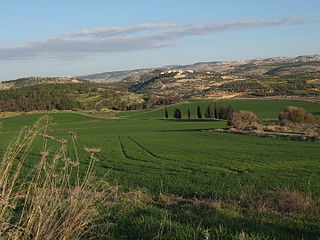| Rabbinical eras |
|---|
Luliani ben Tabrin was a Jewish scholar of the beginning of the fourth century, one of the amoraim of the third generation, in the Land of Israel.
Amoraim refers to the Jewish scholars of the period from about 200 to 500 CE, who "said" or "told over" the teachings of the Oral Torah. They were concentrated in Babylonia and the Land of Israel. Their legal discussions and debates were eventually codified in the Gemara. The Amoraim followed the Tannaim in the sequence of ancient Jewish scholars. The Tannaim were direct transmitters of uncodified oral tradition; the Amoraim expounded upon and clarified the oral law after its initial codification.

The Land of Israel is the traditional Jewish name for an area of indefinite geographical extension in the Southern Levant. Related biblical, religious and historical English terms include the Land of Canaan, the Promised Land, the Holy Land, and Palestine. The definitions of the limits of this territory vary between passages in the Hebrew Bible, with specific mentions in Genesis 15, Exodus 23, Numbers 34 and Ezekiel 47. Nine times elsewhere in the Bible, the settled land is referred as "from Dan to Beersheba", and three times it is referred as "from the entrance of Hamath unto the brook of Egypt”.
His name, which is the equivalent of "Julianus ben Tiberianus," has been corrupted into יולימנא בן עבדי in Pesikta Rabbati. [1] His father's name, the usual form of which is טברין, is written also טברינאי [2] and טורין. [3]

Pesikta Rabbati or P'siqta Rabbita is a collection of aggadic midrash (homilies) on the Pentateuchal and prophetic readings, the special Sabbaths, and so on. It was composed around 845 CE and probably called "rabbati" to distinguish it from the earlier Pesikta de-Rav Kahana (PdRK).
Luliani is frequently mentioned in pre-Talmudic literature and in the Midrash. He is particularly known as the transmitter of aggadot of his teacher, Isaac Nappaha. One aggadah is ascribed to Luliani himself: "When the lesser people listen to the great and yet the latter do not alleviate the burden of the former, they shall account for it to God". [4] However, a similar teaching is elsewhere ascribed to R. Isaac. [5] Luliani is mentioned also as having asked his teacher Isaac a halakhic question. [6]

Midrash is biblical exegesis by ancient Judaic authorities, using a mode of interpretation prominent in the Talmud.
The statement of Midrash Tehillim [7] that Luliani transmitted an aggadah of R. Ishmael is apparently a mistake due to the abbreviation ר"י.

Midrash Tehillim, also known as Midrash Shocher Tov or the Midrash to Psalms, is an aggadic midrash to Psalms.
Luliani was the father of the Hiyya ben Luliani who is frequently mentioned in the Jerusalem Talmud and who is stated to have caused rain to fall in time of drought. [8]

The Jerusalem Talmud, also known as the Palestinian Talmud or Talmuda de-Eretz Yisrael, is a collection of Rabbinic notes on the second-century Jewish oral tradition known as the Mishnah. Naming this version of the Talmud after the Land of Israel rather than Jerusalem is considered more accurate by some because, while the work was certainly composed in "the West", i.e. in the Holy Land, it mainly originates from the Galilee rather than from Jerusalem in Judea, as no Jews lived in Jerusalem at this time. The Jerusalem Talmud was compiled in the Land of Israel, then divided between the Byzantine provinces of Palaestina Prima and Palaestina Secunda, and was brought to an end sometime around 400. The Jerusalem Talmud predates its counterpart, the Babylonian Talmud, by about 200 years, and is written in both Hebrew and Jewish Palestinian Aramaic.

